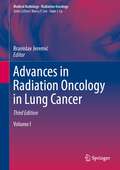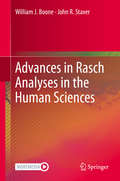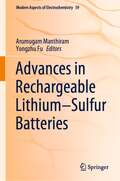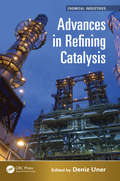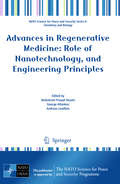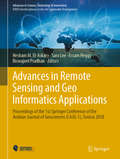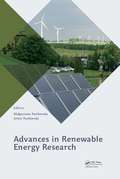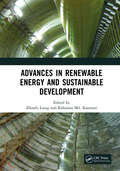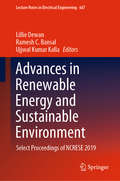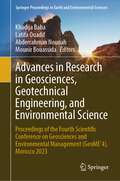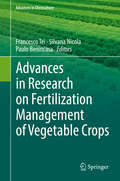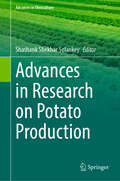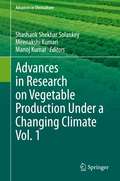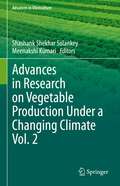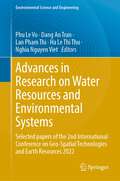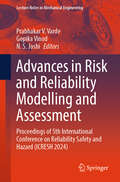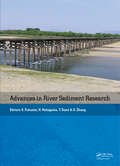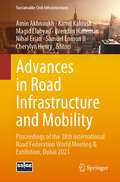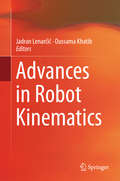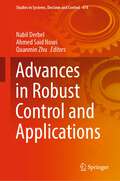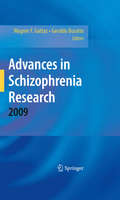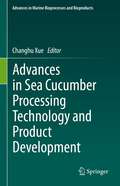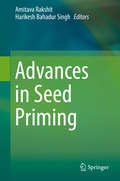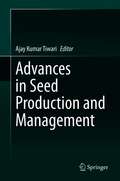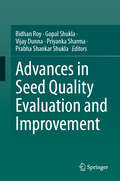- Table View
- List View
Advances in Radiation Oncology in Lung Cancer (Medical Radiology)
by Branislav JeremićThis is the third, completely updated edition of a comprehensive book in which many of the world’s leading lung cancer specialists discuss the recent advances in the radiation oncology of lung cancer and reflect on the latest research findings in lung cancer and other intrathoracic malignancies. Lung cancer remains the major cancer killer in both sexes worldwide. It is so despite significant progress in recent decades in both diagnostic and treatment approaches. New biological and technological advances in this field are now faster incorporated in the overall decision-making process and are bringing fast and substantial improvements in both survivals and quality of life of lung cancer patients. Optimized patient-oriented approaches are reality of the third decade of this millennium and thoracic oncologists strive towards nothing but seamlessly delivering it in a continuous battle with lung cancer. The first three sections of the work cover the basic science of lung cancer, clinical investigations, including histology and staging, and a wide range of fundamental treatment considerations. Current treatment strategies for small cell and non-small cell lung cancer as well as other intrathoracic malignancies are then explained and evaluated in detail, with due attention to novel approaches that promise further improvements in outcome. The various types of treatment-related toxicity are discussed, and quality of life studies and prognostic factors are also considered. After evaluating the latest technological and biological advances, including stereotactic radiotherapy, and particle therapy, the book concludes by thorough consideration of specific aspects of clinical research in lung cancer. This concise yet comprehensive book is an invaluable resource for radiation oncologists.
Advances in Rasch Analyses in the Human Sciences
by William J. Boone John R. StaverThis volume follows the publication of Rasch Analysis in the Human Sciences. This new book presents additional topics not discussed in the previous volume. It examines key topics such as partial credit analysis of data, common person linking, computing equating constants, investigating discrimination, evaluating dimensionality, how to better utilize Wright Maps, how to design tests and surveys using Rasch theory, and many more. The book includes activities which can be used to practice the theme of each chapter and to test the reader’s understanding of Rasch techniques. Beginning and ending with a conversation between two students, each chapter provides clear step-by-step instructions as to how to conduct an analysis using the chapter theme. The chapters emphasize applications for the beginner learning Rasch and provide guidance for composing a write-up of an analysis for a presentation, paper, thesis or report.This book explores in detail many important yet often rarely discussed topics in Rasch. With its easy-to-read language and engaging format it reaches a wide audience of scientists, clinicians, students, researchers and psychometricians, providing a valuable toolkit for practical users of Rasch analysis. – Dr. Eva Fenwick, Clinical Research Fellow, Singapore Eye Research Institute (SERI) Assistant Professor, Duke-NUS Medical School, Singapore It is an easy to read book and provides immediate guidance for those wishing to conduct a Rasch analysis. The “conversations” between students in each chapter provides a welcome introduction to each topic. – Prof. Maik Walpuski, University Duisburg-Essen, GermanyThe lessons learned in their first book are extended by providing insightful demonstrations of some of the more complex concepts and techniques used in applying Rasch models. – Dr. Michael R. Peabody, National Association of Boards of Pharmacy, Illinois, USAI am amazed with the ability of these authors to communicate complicated knowledge, and the ability to make this highly complicated knowledge accessible to new learners guiding every step of the way. Through this book we get important knowledge about techniques and the different areas of use for Rasch methods in the human sciences This is truly an important book for students and researchers. – Prof. Charlotte Ringsmose, Aalborg University, Denmark
Advances in Rechargeable Lithium–Sulfur Batteries (Modern Aspects of Electrochemistry #59)
by Arumugam Manthiram Yongzhu FuThis book presents the latest advances in rechargeable lithium-sulfur (Li-S) batteries and provides a guide for future developments in this field. Novel electrode compositions and architectures as well as innovative cell designs are needed to make Li-S technology practically viable. Nowadays, several challenges still persist, such as the shuttle of lithium polysulfides and the poor reversibility of lithium-metal anode, among others. However over the past several years significant progress has been made in the research and development of Li-S batteries. This book addresses most aspects of Li-S batteries and reviews the topic in depth. Advances are summarized and guidance for future development is provided. By elevating our understanding of Li-S batteries to a high level this may inspire new ideas for advancing this technology and making it commercially viable. This book is of interest to the battery community and will benefit graduate students and professionals working in this field
Advances in Refining Catalysis (Chemical Industries)
by Deniz UnerTo meet changing market demands that have stringent emission standards and to ensure proper performance in refinery units, evaluation of novel catalyst designs and results from material characterization and testing of catalysts are of crucial importance for refiners as well as for catalyst manufacturers. This book highlights recent developments in the application of refinery catalysts in selected units such as fluid catalytic cracking (FCC), hydrogen production for hydroprocessing units, hydrotreating, hydrocracking, and sustainable processing of biomass into biofuels.
Advances in Regenerative Medicine: Role Of Nanotechnology And Engineering Principles (NATO Science for Peace and Security Series A: Chemistry and Biology)
by Andreas Lendlein George Altankov Venkatram Prasad ShastriThe contributions to this book, all written by leading experts in their respective disciplines, describe and explore the various facets of regenerative medicine and highlight the role of the "the nano length scale" and of "nano-scale systems" in defining and controlling cell and tissue environments. The development of novel tissue-regeneration strategies requires the integration of new insights emerging from studies of cell-matrix interactions, cellular signalling processes, and developmental and systems biology, into biomaterials design, ideally via a systems approach. The chapters cover a wide spectrum of topics ranging from stem cell biology, developmental biology, cell-matrix interactions, and matrix biology to surface science, materials processing and drug delivery. The book will be an especially valuable resource for researchers developing regenerative medicine paradigms that combine these facets into clinically translatable solutions.
Advances in Remote Sensing and Geo Informatics Applications: Proceedings Of The 1st Springer Conference Of The Arabian Journal Of Geosciences (CAJG-1), Tunisia 2018 (Advances in Science, Technology & Innovation)
by Biswajeet Pradhan Hesham M. El-Askary Saro Lee Essam HeggyThis edited volume is based on the best papers accepted for presentation during the 1st Springer Conference of the Arabian Journal of Geosciences (CAJG-1), Tunisia 2018. The book compiles a wide range of topics addressing various issues by experienced researchers mainly from research institutes in the Mediterranean, MENA region, North America and Asia. <p><p> Remote sensing observations can close gaps in information scarcity by complementing ground-based sparse data. Spatial, spectral, temporal and radiometric characteristics of satellites sensors are most suitable for features identification. The local to global nature and broad spatial scale of remote sensing with the wide range of spectral coverage are essential characteristics, which make satellites an ideal platform for mapping, observation, monitoring, assessing and providing necessary mitigation measures and control for different related Earth's systems processes. <p> Main topics in this book include: Geo-informatics Applications, Land Use / Land Cover Mapping and Change Detection, Emerging Remote Sensing Applications, Rock Formations / Soil Lithology Mapping, Vegetation Mapping Impact and Assessment, Natural Hazards Mapping and Assessment, Ground Water Mapping and Assessment, Coastal Management of Marine Environment and Atmospheric Sensing.
Advances in Renewable Energy Research
by Malgorzata Pawlowska & Artur PawlowskiAdvances in Renewable Energy Research comprises papers delivered at an international workshop by authors from Poland, Germany, Ukraine, China, Japan and Taiwan. The papers discussed the development of renewable energy technologies in certain countries, with special attention deviated to the conducted scientific research. The greatest attention was paid to the use of biomass, which uses resources that are readily-available in large quantities in all countries. The experience related to the use of biomass for energy generation was presented for certain countries, i.e. Germany and Japan as representatives of the most advanced countries in the field of energy generation from renewable sources, Taiwan and Poland, which have some experience in that area as well, and China and Ukraine, which have just started the introduction of renewable energy technologies. The greatest attention was devoted to the biogas production methods, i.e. chemical, biological, and mechanical pre-treatment methods, as well as enhancement of anaerobic fermentation and purifi cation of the biogas produced. -The development of solar (photovoltaic and thermal) methods and the use of heat pumps in residential buildings are also discussed, mostly with Polish experience asan example. Special attention is paid to research methods to be used for development of renewable energy technologies. Advances in Renewable Energy Research is useful for engineers and researchers working in the renewable energy area.
Advances in Renewable Energy and Sustainable Development: Proceedings of the International Conference on Renewable Energy and Sustainable Development (IRESD 2022), Nanning, China, 20–22 May 2022
by Zhoufu Liang Rafiziana KasmaniAdvances in Renewable Energy and Sustainable Development focuses on cutting-edge research areas including renewable energy and sustainable development. As a leader in the global megatrend of science and technology innovation, China has been creating an increasingly open environment for science and technology innovation, increasing the depth and breadth of academic cooperation, and building an innovation community that benefits all people. These efforts make a new contribution to globalization and the building of a community for a shared future. The proceedings feature the most cutting-edge research directions and achievements related to Renewable Energy and Sustainable Development. Subjects in the proceedings include: Hydraulic Engineering Environmental Science and Environmental Engineering Energy Engineering and Energy Technologies Green Manufacturing Energy Policy and Economics Energy Security and Clean Use Geothermal Energy
Advances in Renewable Energy and Sustainable Environment: Select Proceedings of NCRESE 2019 (Lecture Notes in Electrical Engineering #667)
by Lillie Dewan Ramesh C. Bansal Ujjwal Kumar KallaThis book comprises the select peer-reviewed proceedings of the National Conference on Renewable Energy and Sustainable Environment (NCRESE) 2019. The book brings together the latest developments in harvesting, storing and optimizing alternate and renewable energy resources. It covers latest developments in green energy technologies as well as smart grids, and their applications towards a sustainable environment. The book can be useful for beginners, academicians, entrepreneurs, and professionals interested in renewable energy technologies and sustainable environment practices.
Advances in Research in Geosciences, Geotechnical Engineering, and Environmental Science: Proceedings of the Fourth Scientific Conference on Geosciences and Environmental Management (GeoME’4), Morocco 2023 (Springer Proceedings in Earth and Environmental Sciences)
by Mounir Bouassida Khadija Baba Latifa Ouadif Abderrahman NounahThe industrial acceleration intensifies the negative environmental impacts, mainly in some very sensitive geographical areas. Environmental problems like water stress, deadly floods, scarcity of building materials, and prolonged periods of drought affect southern countries, including African nations. This book comprises the peer-reviewed proceedings of the fourth scientific conference on geosciences and environmental management (GeoME'4), held in Salé, Morocco, on June 22–24, 2023. The book interests all researchers, practitioners, and students in geosciences, the environment, and water management.The book delivers a comprehensive overview of the latest research covering the following aspects of green technologies for sustainable water and wastewater management: nature-based solutions in the water cycle and advanced technologies in geosciences, geotechnics, and the environment. Additionally, it features six keynote speakers by international experts, providing valuable insights and further enhancing its value as a comprehensive resource on the following topics: Water management Environmental engineeringGeosciences and geotechnical engineering
Advances in Research on Fertilization Management of Vegetable Crops (Advances in Olericulture)
by Francesco Tei Silvana Nicola Paolo BenincasaThis book is a review of the recent literature on the key scientific and technical subjects of fertilization management in vegetable crops. In the last decades, research on fertilization management in vegetables was aimed at producing economical yields with reduced fertilizer inputs by the development and implementation of cropping systems, nutrient management approaches and crop varieties. Examples of the interventions in cropping systems included adequate crop rotations, inter-cropping, double cropping, and other strategies for a better soil organic matter management; nutrient management approaches included modelling, Decision Support Systems, crop nutritional status testing and precision agriculture technologies; amelioration of crop varieties has been directed toward higher nutrient/fertilizer use efficiency.
Advances in Research on Potato Production (Advances in Olericulture)
by Shashank Shekhar SolankeyPotato (Solanum tuberosum L.) is the world&’s third-most important food crop and the fourth-most important food crop in India. Potatoes are nutritionally rich, fat free, gluten free and high in dietary fibre. They are also a good source of vitamin C, vitamin B6, phenols, iron, potassium, phosphorus, magnesium and protein as compared to cereals. They are more energy-packed than any other popular vegetables and have the ability to combat hidden hunger, which is a major global health issue. The potato is also considered the &‘king of vegetables&’ due to its versatile uses and is an important staple food worldwide According to the FAOSTAT database (2023), global potato production in 2022 was 375 million tonnes, with the top producers being China (95.5 million tonnes) and India (56 million tonnes). The United Nations declared 2008 the International Year of the Potato (IYP) to increase awareness of the relationship that exists between poverty, food security, malnutrition and the potential contribution of the potato in defeating hunger. Moreover, this magical crop can generate a higher yield compared to the other crops; hence, it is one of the most notable crops to eliminate hunger and poverty. Therefore, sustainable potato production is important for food security and social welfare in future climate change scenarios. It is important to inform that potatoes have a shallow root system and are highly sensitive to environmental conditions and climate change. It is projected that potato yield may decrease up to 32 per cent by 2050 due to increasing temperatures and drought conditions. Thus, future potato breeding programmes should focus on enhancing abiotic and biotic stress tolerance through the utilization of the natural germplasm conserved in different gene banks along with climate friendly agronomical practices. Moreover, potato breeding should benefit from the effectiveness and ease of molecular techniques such as marker assisted selection, genome wide association studies, functional genomics and transgenics. The development of new potato varieties can also be achieved via genetic engineering and genome editing. Disease free potato seed production requires the integration of tissue culture methods, followed by the production of mini-tubers under an aeroponic system. As it is a staple food for millions and demand for potatoes will increase in the future, which makes this crop suitable for future research. Hence, the present book is formulated for professionals, researchers and post-graduate students who is working with advanced production, breeding and post-harvest technologies on potato crop specially in Indian perspective.
Advances in Research on Vegetable Production Under a Changing Climate Vol. 1 (Advances in Olericulture)
by Manoj Kumar Shashank Shekhar Solankey Meenakshi KumariA considerable change in climate at a global level will impact the vegetable cultivation and agriculture as a whole; subsequently affecting the world's food supply. Climate change per se is not necessarily harmful; the problems arise from extreme events that are difficult to predict (erratic rainfall patterns and unpredictable high and low temperatures), and consequently reduce crop productivity. Vegetables are in general more succulent (have 90% water) and are more sensitive to climatic vagaries. Sudden changes in temperature coupled with irregular precipitation at any phase of crop growth can affect the normal growth, flowering, pollination, fruit setting, fruit development and fruit ripening can decrease the yield. The irregular precipitation can also affect the soil salinity and is a major challenge in many vegetable growing areas. To mitigate the harmful impact of climatic change there is a urgent need to develop adequate adaptation strategies for adverse effect of climate change and the preference should be given on development of heat, cold, drought, flood and salinity stress tolerant genotypes along with climate proofing through conventional and non-conventional breeding techniques. Available evidence shows that there is a high probability of increase in the frequency and intensity of climate related natural hazards due to climate change and hence increases the potential threat due to climate change related natural disasters in the world. This book (Volume- I) will be basically useful for the researchers and postgraduate students with current challenges and mitigation strategies for increasing vegetable production under a changing climate.
Advances in Research on Vegetable Production Under a Changing Climate Vol. 2 (Advances in Olericulture)
by Shashank Shekhar Solankey Meenakshi KumariThis second volume on the topic will be extremely useful for the researchers and postgraduate students working on vegetable crops with a special focus on climate change. Today, the entire world is suffering from global warming and its consequent, climate change. This has emerged as the most prominent global environmental issue and there is an urgent need to mitigate its impact on agriculture. Over the past 20 years South Asia has had a robust economic growth, yet it is home to more than one fourth of the world’s hunger and 40% of the world’s malnourished children and women. Persistent climatic variability, which results in frequent drought and flood, is among the major reasons for this phenomenon. Vegetables are in general more succulent (have 90% water) and more sensitive to climatic vagaries and sudden changes in temperature, as well as irregular precipitation at any phase of crop growing, can affect the normal growth, flowering, pollination, fruit setting, fruit development and fruit ripening which eventually decreases the yield. The irregular precipitation also causes the soil salinity and is a major challenge in many vegetable growing areas. To mitigate the harmful impact of climatic change there is an urgent need to develop adequate adaptation strategies for adverse effect of climate change and preference should be given to the development of heat, cold, drought, flood and salinity stress tolerant genotypes along with climate proofing through conventional and non-conventional breeding techniques, as well as exploiting the beneficial effects of CO2 enhancement on crop growth and yield. Available evidence shows that there is high probability of increase in the frequency and intensity of climate related natural hazards due to climate change and hence increase the potential threat due to climate change related natural disasters in the world. At present protected cultivation and grafted seedlings are also popularizing among vegetable growers because of the huge scope as well as, molecular breeding, emerging insect-pests & diseases and postharvest quality of vegetables under this climate change scenario. Moreover, underexploited vegetables, perennial vegetable and tuber crops have a more tolerant ability to climate vagaries compare to major vegetables which are also discussed in this book.
Advances in Research on Water Resources and Environmental Systems: Selected papers of the 2nd International Conference on Geo-Spatial Technologies and Earth Resources 2022 (Environmental Science and Engineering)
by Phu Le Vo Dang An Tran Thi Lan Pham Ha Le Thi Thu Nghia Nguyen VietThis book composes the proceedings of the international Conference on Geo-Spatial Technologies and Earth Resources (GTER 2022) which was co-organized by Hanoi University of Mining and Geology and the International Society for Mine Surveying (ISM) held at Hanoi city on October 13–14, 2022.GTER 2022 is technically co-sponsored by Vietnam Mining Science and Technology Association (VMST), Vietnam Association of Geodesy, Cartography and Remote Sensing (VGCR), Vietnam National Coal-Mineral Industries Holding Corporation Limited (VINACOMIN), and the Dong Bac Corporation (NECO).GTER 2022 aims to bring together experts, researchers, engineers, and policymakers to discuss and exchange their knowledge and experiences in recent advances research water resources and environmental systems.
Advances in Risk and Reliability Modelling and Assessment: Proceedings of 5th International Conference on Reliability Safety and Hazard (ICRESH 2024) (Lecture Notes in Mechanical Engineering)
by Prabhakar V. Varde Gopika Vinod N. S. JoshiThis book presents the proceedings of the 5th International Conference on Reliability Safety & Hazard-2024, held in Mumbai during February 21–24, 2024. It covers the latest advances in artificial intelligence and machine learning in development of risk-conscious culture. Various topics covered in this volume are reliability prediction, precursor event analysis, fuzzy reliability, structural reliability, passive system reliability, digital system reliability, risk-informed approach to decision making, dynamic PSA, uncertainty and sensitivity modeling, among others. The book is a valuable resource for researchers and professionals working in both academia and industry in the areas of complex systems, safety-critical systems, and risk-based engineering.
Advances in River Sediment Research
by Hao Zhang Tetsuya Sumi Shoji Fukuoka Hajime NakagawaThis book covers recent accomplishments in theoretical developments, numerical simulations, laboratory experiments, field investigations and management methodologies of river sediment related issues, and may serve as a reference book for graduate students, researchers, engineers and practitioners in disciplines of hydraulic, environmental, agricultural and geological engineering.
Advances in Road Infrastructure and Mobility: Proceedings of the 18th International Road Federation World Meeting & Exhibition, Dubai 2021 (Sustainable Civil Infrastructures)
by Amin Akhnoukh Kamil Kaloush Magid Elabyad Brendan Halleman Nihal Erian Samuel Enmon II Cherylyn HenryThis volume focuses on recent advances in the planning, design, construction and management of new and existing roads with a particular focus on safety, sustainability and resilience. It discusses field experience through case studies and pilots presented by leading international subject-matter specialists. Chapters were selected from the 18th International Road Federation World Meeting & Exhibition, Dubai 2021.
Advances in Robot Kinematics: Mechanisms And Motion (Springer Proceedings In Advanced Robotics Ser. #4)
by Jadran Lenarčič Oussama KhatibThe topics addressed in this book cover the whole range of kinematic analysis, synthesis and design and consider robotic systems possessing serial, parallel and cable driven mechanisms. The robotic systems range from being less than fully mobile to kinematically redundant to over constrained. The fifty-six contributions report the latest results in robot kinematics with emphasis on emerging areas such as design and control of humanoids or humanoid subsystems. The book is of interest to researchers wanting to bring their knowledge up to date regarding modern topics in one of the basic disciplines in robotics, which relates to the essential property of robots, the motion of mechanisms.
Advances in Robust Control and Applications (Studies in Systems, Decision and Control #474)
by Quanmin Zhu Nabil Derbel Ahmed Said NouriThe book presents recent applications and developments in the field of control of industrial systems, covering a wide range of modeling and feedback control using various robust approaches such as fuzzy systems, sliding mode control, and H-infinity. This book provides insights into theory, applications, and perspectives relevant to the field of robotic systems, exoskeletons, power systems, photovoltaic systems, etc., as well as general methodologies and paradigms around them. Each chapter provides an enriched understanding of a research topic along with a balanced treatment of the relevant theories, methods, or applications. It reports on the latest advances in the field. This book is a good reference for graduate students, researchers, educators, engineers, and scientists and contains a total of 15 chapters divided into five parts as follows. The first part of this book focuses on the application of fuzzy control to robotic systems and consists of three chapters. The second part of this book proposes the control of lower and upper limb exoskeletons and includes two chapters. The third part is dedicated to the control of power systems and comprises three chapters. The fourth part deals with various approaches to the modeling and control of industrial processes and comprises four chapters. The fifth and final part describes observers and fault-tolerant control systems and comprises five chapters.
Advances in Schizophrenia Research 2009
by Geraldo Busatto Filho Wagner F. GattazSchizophrenia remains an important challenge to psychiatry, with its causes and underlying brain mechanisms yet to be fully revealed. Currently available treatments are neither universally effective nor without unwanted effects. These aspects, together with the high prevalence of schizophrenia, its often debilitating nature, and the associated family and social burden, make this mental disorder one of the most complex public health issues of our times. The purpose of the Advances in Schizophrenia Research series is to provide comprehensive periodic reviews of the wide range of research studies carried out around the world, with the dual purpose of solving the schizophrenia puzzle, and providing clues to new forms of treatment and prevention for this disorder. A special feature of the series is its broad scope, virtually encompassing all fields of schizophrenia research: epidemiology and risk factors; psychopathology; diagnostic boundaries; cognition; outcome and prognosis; pathophysiology; genetics; pharmacological and psychological forms of treatment and rehabilitation; community care; and stigmatization.
Advances in Sea Cucumber Processing Technology and Product Development (Advances in Marine Bioprocesses and Bioproducts)
by Changhu XueSea cucumbers belong to the Phylum Echinodermata. There are more than 900 recorded species of sea cucumber of which more than 40 are edible. As a food source, sea cucumbers are rich in protein, low in fat, rich in collagen, sulfated polysaccharides, phospholipids, glycolipids, saponins and other functional components. Therefore, sea cucumbers have important nutritional and medicinal value. Growing awareness of these health benefits has promoted growth in marine aquaculture and processing technologies for the development of sea cucumber products for many applications.Novel perspectives of nutritional functions and processing technologies of sea cucumbers are defined in this book. The chemical structure and nutritional function of sea cucumbers are systematically reviewed. These include the functional/nutritional components, the endogenous enzymatic properties related to processing efficiency and product quality, and the efficient preparation technology of functional components. The traditional processing technology is presented as the background context to highlight the advances in new processing technologies including low-temperature cooking technology based on controllable negative pressure system, heat pump-hot-blast air combined drying technology, microwave sterilization of instant sea cucumber, collagen stabilization technology. The book finishes with the authentication of sea cucumber types and origin, quality standards, product quality control systems and food safety requirements.
Advances in Seed Priming
by Harikesh Bahadur Singh Amitava RakshitMost crop plants grow in environments that are suboptimal, which prevents the plants from attaining their full genetic potential for growth and reproduction. Stress due to abiotic and biotic agents has a significant effect on world food production. Annually, an estimated 15% of global yields are lost, but this figure belies far greater losses for specific food systems and the people whose existence is dependent upon them, particularly in developing countries. Current efforts to mitigate these losses are worryingly over-reliant on the use of sophisticated and costly chemicals /measures with substantial economic and environmental costs, or on the development of efficient and smart crop varieties, which can take decades. What we need is a broad range of safe, robust and equitable solutions for food producers. One under-investigated approach is that of utilizing the crop plant’s innate immune system to resist stress. More specifically, the innate immune system can be sensitized or ‘primed’ to respond more quickly and strongly to protect the plant against stresses. However, a strategy of employing priming in combination with reduced pesticide use can enhance protection, and help to meet commitments to reducing chemical inputs in agriculture. This book discusses in detail different segments of priming in addressing stress factors and traits to increase competitiveness against all odds. Adopting a holistic and systematic approach, it addresses priming to counter climate-change related adverse effects coupled with pest and pathogen related stress on the productivity of crops utilizing natural resources to reap sustainable environmental, economic and social benefits for potential productivity of crops, maintaining synergy between soil, water and plants in ways that mimic nature.
Advances in Seed Production and Management
by Ajay Kumar TiwariHigh-quality seed is essential for healthy crops and greater agricultural productivity. At the same time, advances in breeding technology require equivalent advances in seed technology. In order to ensure food security, it is crucial to develop seeds that are high yielding, and resistant to drought, heat, cold, and insects. Gathering the latest research in seed sciences, the book includes contributions on seed production in crops such as legumes, sugar, rice, wheat and other cereals. It discusses a range of topics, like the effect of climate change on seed quality, production and storage; seed rouging; seed certification for different crop species; seed biology; and seed pathologies and their effective management. Integrating basic and applied research, this compendium provides valuable insights for researchers and students in agricultural and life sciences; professionals involved in seed certification and those working in quarantine laboratories; as well as plant pathologists.
Advances in Seed Quality Evaluation and Improvement
by Gopal Shukla Priyanka Sharma Bidhan Roy Vijay Dunna Prabha Shankar ShuklaThis book discusses various aspects of Seed Science and Technology including seed production, seed certification, seed quality enhancements, seed testing and harvesting, and post-harvest management. Continued efforts are being made to preserve plant genetic resources over long term in order to conserve biodiversity and provide food security. Seed and germplasm repositories hold high importance in this regard. Various technologies such as cryopreservation is being commonly employed to preserve seeds and plant tissues at extremely low temperatures. This book discusses the advancements of data storage and information management systems that have aided in the creation of extensive seed databases, and thus enabling researchers to quickly catalogue and access data on seed kinds, properties and availability. This book also explains the sophisticated technologies such as nanobiotechnology, machine learning, artificial intelligence, magnetic resonance and multispectral imaging which are currently being used for examining seed quality, genetic analysis, seed preservation and seed handling operations. The scope of these technologies in increasing the effectiveness and precision of seed research, developing better crop varieties and promoting sustainable environmental preservation has also been covered. This book is a reference source for Scientists, researchers and authorities involved in the production and certification of seeds. It is also valuable for seed experts working in the public and commercial sectors globally.
